Four digital pillars to accelerate the future of ship design
The annual NAPA User Meeting is a one-of-a-kind event, bringing together over 150 ship design experts around a single goal: exchange knowledge to solve practical problems today, and build a smarter and more efficient future for the industry as a whole.
The 2024 edition was no exception. Under the glorious Spanish sun in Malaga, pioneering companies showed how they are already making strides toward new tools and workflows that foster innovation and collaboration. The future of ship design is already taking shape today, and here are four tangible examples of what it holds for the industry.
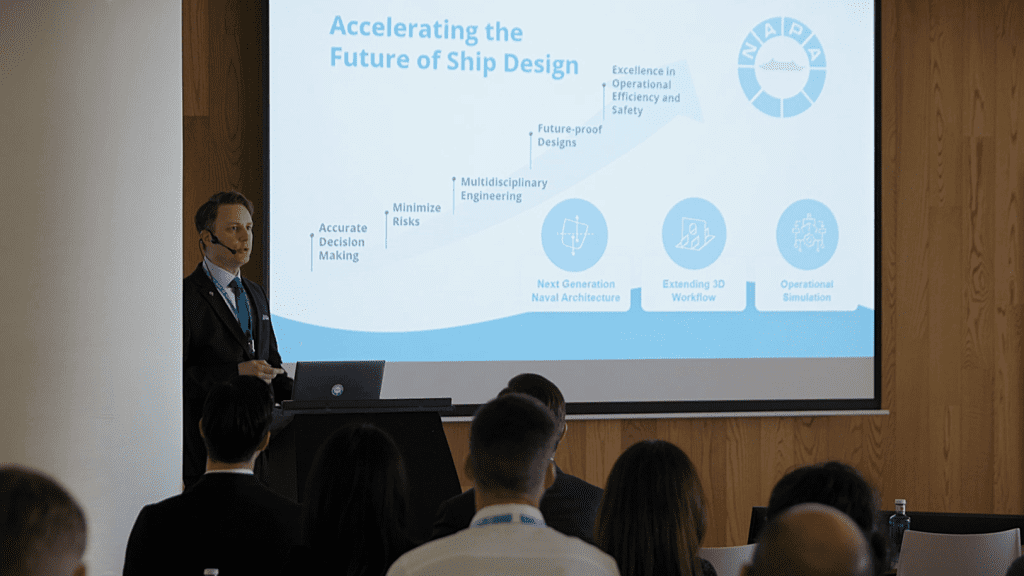
Mikko Forss, Executive Vice President of Design Solutions in NAPA, is giving a presentation ‘Accelerating the Future of Ship Design’ which is the theme of NAPA User Meeting 2024.
1. Extended 3D workflows will enable collaborative and concurrent design.
While using 3D models in ship design isn’t new, the real game-changing potential is deploying those models as a “single source of truth” throughout the process, from initial concepts to basic and detailed design. This enables concurrent engineering, saving tremendous time and limiting the risk of inconsistencies as the project progresses. Ultimately, interfaces with production systems will also enable data from this basic and detailed design stage to be reused in the production design, unlocking further significant time savings as well as the potential of using the 3D model as a “digital twin” throughout the vessel’s lifecycle.
These efficiency gains are a “must-have” to future-proof our industry. The energy transition will continue to increase the complexity of designs, requiring novel concepts that integrate new fuels and energy sources to meet new environmental regulation and shipping’s decarbonization goals. Efficient collaboration between the different disciplines involved in ship design is essential to manage this complexity. This is where a more holistic approach can add value for ship designers.
The NAPA User Meeting 2024 saw formidable examples of these 3D workflows in action. For instance, Kawasaki Heavy Industries demonstrated how they used 3D tools to develop a completely new concept of a large Liquefied Hydrogen (LH2) carrier. Using one NAPA model from the initial development to detail design stages, their teams could work on outfitting arrangement and structure simultaneously, which increased efficiency and helped identify challenges early.
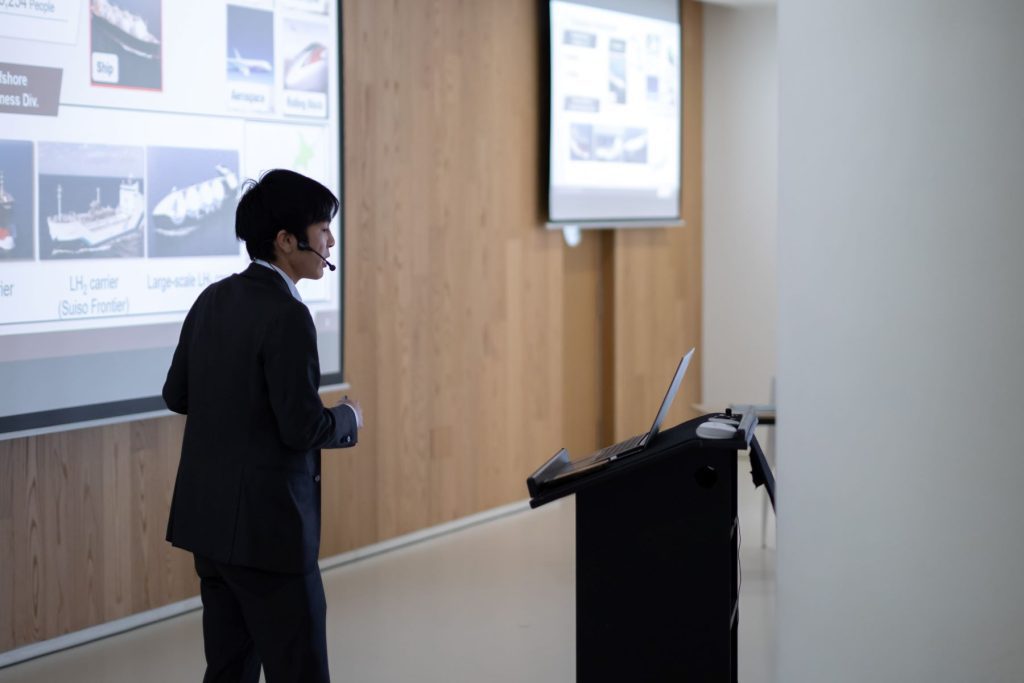
Ryuta Yoshida, Naval Architect from Kawasaki Heavy Industries is giving a presentation ‘Utilization of NAPA Steel in the development and design of a completely new concept ship’.
In another presentation, Vard Marine explained how they use NAPA tools to perform stability calculations early on, enabling their teams to assess the viability of innovative designs from the outset and deliver tailor-made vessels for their customers.
2. 3D approvals gaining momentum.
Another practical application of 3D models that will only grow going forward is for classification approvals. A number of forward-thinking shipyards, engineering companies and classification societies are working on projects to perform classification checks directly using the 3D model that was created to design the vessel, rather than requiring multiple lengthy conversions to 2D drawings.
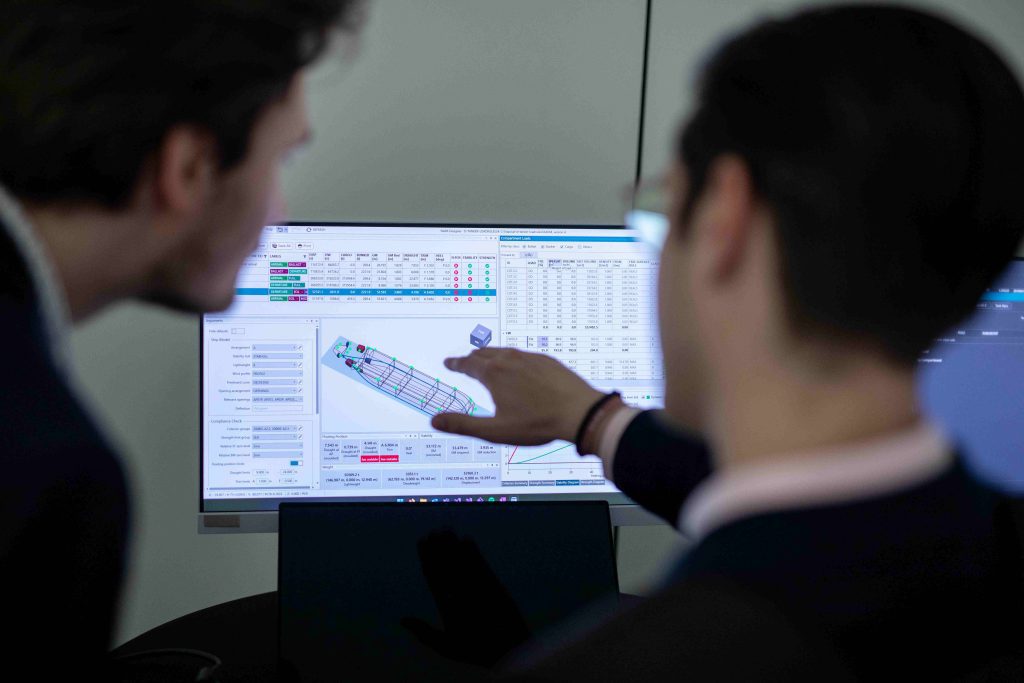
NAPA Designer is an easy-to-use and efficient software for ship design, providing features from hull form design to inner geometry, compartment modeling and structural design.
At the NAPA User Meeting 2024, several ship designers and classification societies, including ABS, ClassNK, DNV, Nihon Shipyard and VARD, spoke of the practical benefits of 3D model-based approvals (3D MBA), which they already see in their work. Whether through the use of NAPA 3D models for class revision by utilizing bi-directional integration of prescriptive rule checks and NAPA, or aiming to reduce the lead time of FE analysis, their testimonies showed how 3D MBA removes duplicated work, saves time, enhances collaboration and helps improve the quality of designs. When 3D approval is properly integrated within the engineering workflow, it can really pave the way of the future for the industry.
3. Next-generation naval architecture and engineering tools will unlock a new level of productivity.
The latest generation of NAPA tools opens the door to interactive design and engineering for functions as varied as hull form and geometry, loading conditions, hydrostatics and intact stability. In addition, intuitive design platforms allow for a wide range of naval architecture analysis and calculations to take place seamlessly, with reliable and trusted results.
These tools enable a more intuitive user experience and a more efficient handling of design changes. Not only can errors and issues be spotted earlier, but managing multiple iterations to deliver unprecedented concepts also becomes possible. At the NAPA User Meeting, this was illustrated by Meyer Turku, who explained how NAPA tools played a central role in developing the Icon of the Seas, the largest cruise vessel in the world – from the concept phase throughout the whole design and building phases.
And we continue to push the boundaries. We are currently developing NAPA Engineer, a next-generation design and engineering platform for naval architects. Among other benefits, the system uses node networks to connect the different design disciplines, ensure data consistency, and manage changes seamlessly.
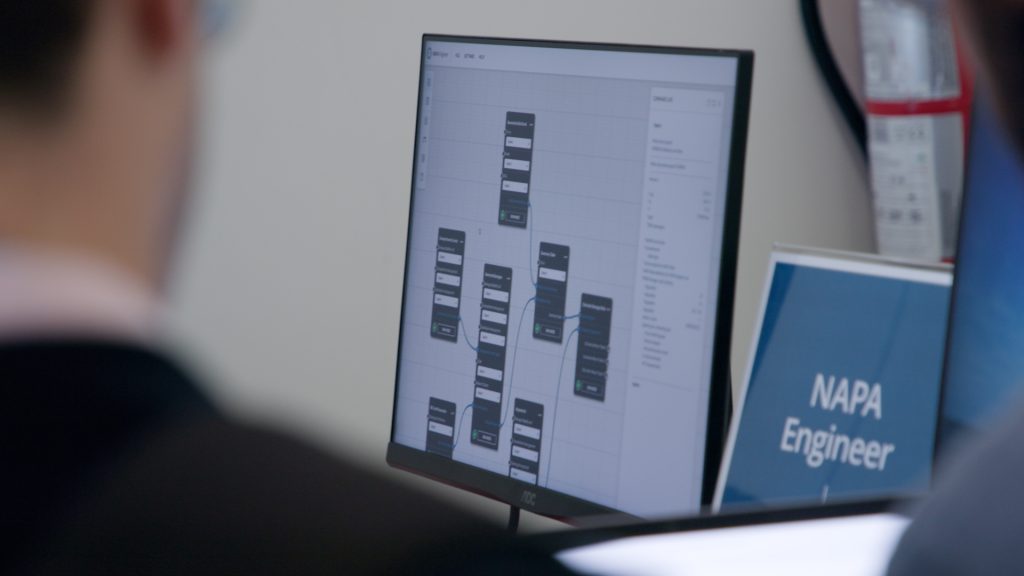
The NAPA Engineer was available for testing at the NAPA Showroom during the NAPA User Meeting 2024.
4. Operational simulations will help inform critical design decisions.
Finally, operational simulation capabilities open a formidable new opportunity for designers and engineers: testing the viability of completely new vessel concepts from the early design phases.
By combining 3D design tools with historical data on real sea conditions on the specific routes where a ship will be operated, we can create highly accurate models that predict how a vessel concept would perform in real life. This enables teams to test different design iterations, both for newbuilds and retrofit projects.

Joakim Heinolainen, Techincal consultant and Janne Huotari, Senior R&D Engineer in Design Solutions, NAPA are giving a presentation ‘Utilization of predicted operational data in ship concept design’
This is a powerful tool for forming critical design decisions, such as determining optimal configurations for ships powered by ammonia, methanol or batteries, or assessing the impact of energy-saving appliances like wind propulsion.
As we enter the multi-fuel era, it is essential for naval architects and engineers to understand how the ships they design today will be operated – on what routes and conditions – so they can determine what technologies and energy sources will be most suitable. In short, there is a need and opportunity to bridge the gap between ship design and operations, using operational data to fine-tune new designs. This will help shipyards as well as shipowners make better-informed decisions, grounded in data-driven evidence.
Why we need to get these four pillars right
Put together, these four pillars are the foundation of a more efficient and collaborative future for ship design. Simulation tools will enable accurate decision-making from the early stages, minimizing risks. 3D workflows will make processes more agile and efficient between the different disciplines involved within a company, but also with external stakeholders, including classification societies.
But to unlock this future, we must get the transition right today. As Dr. George Westerman, a principal research scientist with the MIT Sloan Initiative on the Digital Economy, noted: “When digital transformation is done right, it’s like a caterpillar turning into a butterfly, but when done wrong, all you have is a really fast caterpillar”.
Getting the transition right is as much about people as it is about technology. The deployment of digital tools must be tailored to each company’s specific needs, and user experience must be at the forefront when developing those tools in the first place. Only then can everyone, from boardrooms to drawing boards, embrace the digital transition as an asset to deliver better designs for their clients, and do so while maintaining strong, thriving businesses.
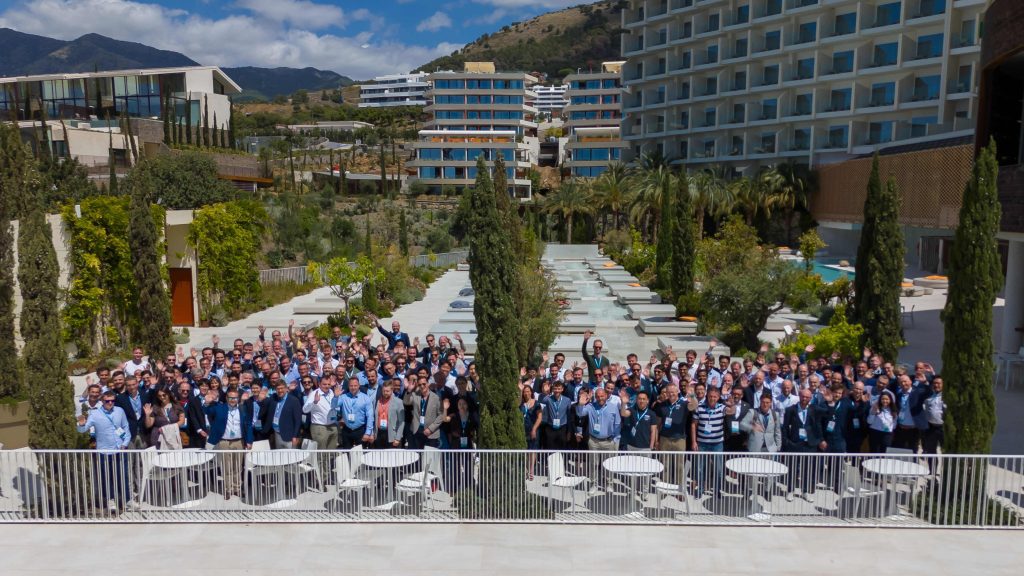
NAPA User Meeting 2024 in Malaga, Spain
With the remarkable collaboration and pioneering spirit that I saw at our NAPA User Meeting 2024, I am confident that we will shape a bright future for ship design, together.



